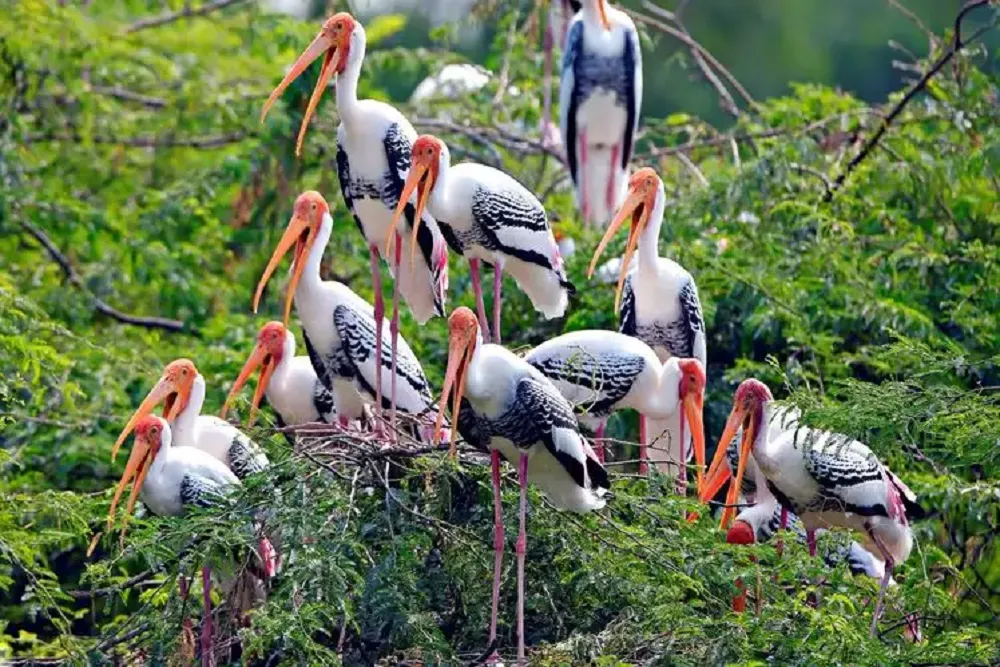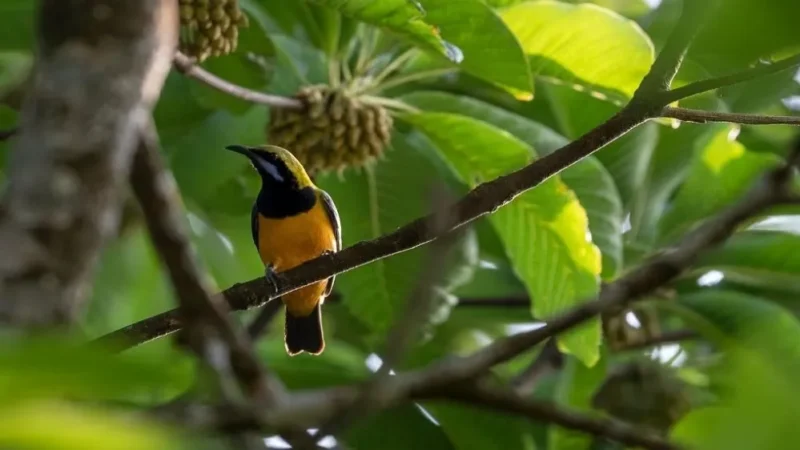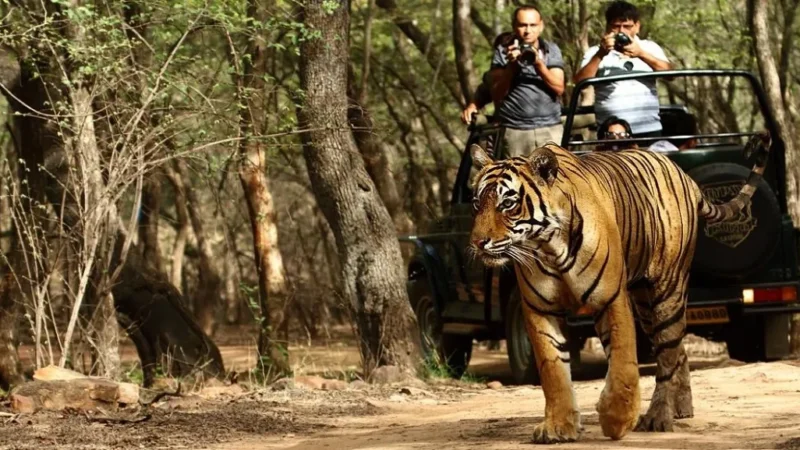Best 7 Wildlife Sanctuary Near Delhi

Table of Contents
ToggleWildlife Sanctuary in Delhi -
Welcome to our wildlife adventure as we delve into the hidden gems of Delhi’s natural world. Beyond the bustling cityscape and urban life lies a fascinating array of wildlife sanctuaries that offer a sanctuary for various flora and fauna. Join us on a journey to uncover the rich biodiversity and serene landscapes that coexist harmoniously with the bustling metropolis.
Delhi, the heart of India, is renowned for its historical monuments, vibrant culture, and dedication to preserving its natural heritage. Within its city limits and in the nearby National Capital Region (NCR), several wildlife sanctuaries and protected areas provide refuge to many species, from migratory birds to elusive mammals.
Our blog aims to serve as a comprehensive guide, highlighting each sanctuary’s unique features and ecological importance. We will take you on virtual tours through lush greenery, wetland habitats, and diverse ecosystems that support the region’s rich wildlife.
1- Asola Bhatti Wildlife Sanctuary
The Asola Bhatti Wildlife Sanctuary, also known as the Asola Wildlife Sanctuary, is located in southern Delhi, India. It is one of the few remaining protected areas within the National Capital Territory of Delhi and serves as a crucial green lung amidst the urban landscape.
Key Features of Asola Bhatti Wildlife Sanctuary:
- Biodiversity: The sanctuary is spread over approximately 32 square kilometers and is known for its rich biodiversity. It is home to various plant and animal species, including mammals, reptiles, amphibians, and avian fauna.
- Flora: Asola Bhatti is characterized by a mix of dry deciduous forest, thorn scrub, and semi-arid vegetation. The sanctuary is dotted with Dhau, Ber, Neem, and Acacia trees, providing a habitat for diverse wildlife.
- Fauna: The sanctuary is inhabited by various wildlife species, such as the Indian hare, Indian crested porcupine, Indian gray mongoose, black-naped hare, and various reptiles like monitor lizards and snakes. During the winter, birdwatchers can spot various avian species, including migratory birds.
- Adventure and Eco-Tourism: Asola Bhatti Wildlife Sanctuary offers nature enthusiasts and adventure seekers an opportunity to explore its rugged terrain through trekking and hiking trails. There are several designated paths for visitors to enjoy nature walks and experience the tranquility of the natural surroundings.
- Conservation Efforts: The Delhi Forest Department manages and protects the sanctuary to preserve its unique ecosystem and wildlife. There are ongoing efforts to create awareness about the importance of biodiversity and the need for conservation.
- Education and Awareness: Asola Bhatti Wildlife Sanctuary also serves as an educational destination, hosting eco-awareness programs and nature camps to promote environmental conservation among students and visitors.
Visiting the Asola Bhatti Wildlife Sanctuary is an excellent opportunity to connect with nature and witness the beauty of wildlife without traveling far from the city. The sanctuary offers a much-needed respite from the hustle and bustle of urban life, making it a popular destination for nature lovers, birdwatchers, and those seeking outdoor activities.
2- Okhla Bird Sanctuary
Okhla Bird Sanctuary is a significant avian habitat located on the banks of the Yamuna River on the Delhi-Uttar Pradesh border. It is situated near the Okhla Barrage, about 15 kilometers south of the city center of Delhi. This bird sanctuary is a vital refuge for migratory and resident bird species, making it a paradise for birdwatchers and nature enthusiasts.
Key Features of Okhla Bird Sanctuary:
- Avian Diversity: Okhla Bird Sanctuary is renowned for its diverse avian population. It provides a temporary home to numerous migratory birds during the winter months, which travel thousands of kilometers from their breeding grounds in the northern regions. The sanctuary also supports a wide range of resident bird species.
- Migratory Season: The sanctuary comes alive with the arrival of migratory birds between October and March. Visitors can witness the stunning sight of flocks of birds such as the northern pintail, northern shoveler, common teal, gadwall, and various species of herons and storks.
- Birdwatching Opportunities: Birdwatchers and photographers have ample opportunities to observe and capture the avian diversity in their natural habitat. The sanctuary has designated watchtowers and viewpoints for visitors to get a closer look at the birds.
- Eco-Tourism and Boating: Apart from birdwatching, the Okhla Bird Sanctuary offers eco-tourism activities, including nature walks and boating in designated areas. These activities provide visitors with a chance to explore the unique flora and fauna of the sanctuary.
- Conservation Efforts: The sanctuary is managed and protected by the Uttar Pradesh Forest Department, which works to conserve the delicate ecosystem and provide a bird haven. Efforts are made to raise awareness about preserving natural habitats and protecting the biodiversity within the sanctuary.
- Educational Programs: Okhla Bird Sanctuary conducts educational programs and awareness campaigns to promote environmental conservation and bird protection among school students and visitors.
Visiting Okhla Bird Sanctuary is a rewarding experience for anyone interested in birdwatching and nature appreciation. The sanctuary’s proximity to Delhi makes it easily accessible, allowing city dwellers to escape into the tranquility of the natural world and witness the wonders of avian life.
3- Sultanpur National Park
Sultanpur National Park, also known as Sultanpur Bird Sanctuary, is a popular avian sanctuary in Gurgaon district, Haryana, approximately 50 kilometers from Delhi. It is a haven for birdwatchers and nature enthusiasts, offering a delightful experience amidst the diverse birdlife and serene surroundings.
Key Features of Sultanpur National Park:
- Migratory Birds: Sultanpur National Park is renowned for attracting many migratory birds during the winter months, between October and March. The park provides a suitable wintering habitat for several species of birds that travel thousands of kilometers from their breeding grounds in Central Asia and Europe.
- Avian Diversity: The sanctuary is home to over 250 bird species, making it a rich reservoir of avian diversity. Visitors can spot various birds, including the Siberian crane, greater flamingo, demoiselle crane, bar-headed goose, spot-billed pelican, and many more.
- Birdwatching Opportunities: Sultanpur National Park offers excellent birdwatching opportunities with well-maintained bird hides and observation points. Birdwatchers and photographers can capture glimpses of these beautiful creatures in their natural habitat.
- Nature Trails: The sanctuary has well-defined nature trails that allow visitors to explore the park’s diverse flora and fauna while enjoying peaceful walks amidst nature.
- Conservation Efforts: Managed and protected by the Haryana Forest Department, Sultanpur National Park focuses on conserving its unique ecosystem and preserving bird habitats. Efforts are made to maintain the park’s natural environment to support the thriving birdlife.
- Eco-Tourism Facilities: The park offers eco-friendly facilities, including watchtowers and interpretive signage, to educate visitors about the significance of bird conservation and environmental protection.
- Visitor Amenities: Sultanpur National Park provides amenities such as clean restrooms, food stalls, and a visitor center that offers information about the sanctuary and its inhabitants.
Visiting Sultanpur National Park is a treat for bird enthusiasts and nature lovers. The sanctuary’s proximity to Delhi makes it easily accessible for day trips, making it a popular weekend getaway destination for families and individuals seeking a peaceful retreat amidst nature.
4- Kalesar National Park
Kalesar National Park is a protected area in Haryana, approximately 150 kilometers from Delhi. It is a significant wildlife sanctuary and an essential part of Haryana’s efforts to conserve its biodiversity.
Key Features of Kalesar National Park:
- Flora and Fauna: Kalesar National Park is characterized by diverse flora and fauna. The park’s forested areas consist of mixed tropical dry deciduous forests, and it is home to various wildlife species, including leopards, sambar deer, chital, wild boar, langurs, and more.
- Avian Diversity: The park provides a habitat for various bird species, making it an attractive destination for birdwatchers and nature enthusiasts. Birdwatching in Kalesar National Park allows visitors to spot numerous avian species, including various migratory birds during winter.
- Natural Landscape: The park’s picturesque landscapes, comprising hills, valleys, and forested areas, offer visitors a serene escape into nature. It provides a peaceful environment for nature walks and wildlife observation.
- Conservation Efforts: Kalesar National Park is protected and managed by the Haryana Forest Department to conserve its natural resources and safeguard its wildlife population. Conservation initiatives aim to preserve the park’s biodiversity and raise awareness about the importance of wildlife conservation.
- Eco-Tourism Activities: The park offers opportunities for eco-tourism activities, such as nature walks and guided tours, allowing visitors to experience the beauty of its wilderness.
- Accessibility: Kalesar National Park is accessible from various nearby cities, including Delhi, making it a popular weekend getaway for those seeking a break from the urban hustle.
5- Dhanauri Wetland Conservation Reserve:
Dhanauri Wetlands, also known as Dhanauri Wetland Conservation Reserve, is a significant wetland conservation area near Delhi.
Key Features of Dhanauri Wetlands:
- Location: Dhanauri Wetlands are in Gautam Buddha Nagar district in Uttar Pradesh, approximately 35 kilometers from Delhi. The wetlands are easily accessible from the national capital, making them a popular destination for birdwatchers and nature enthusiasts.
- Wetland Biodiversity: Dhanauri Wetlands serve as an essential habitat for diverse flora and fauna. The wetlands are especially renowned for attracting various bird species, both migratory and resident, making it an ideal spot for birdwatching.
- Avian Diversity: The wetlands attract migratory birds during the winter season, allowing birdwatchers to spot various species, including waterfowl, waders, ducks, herons, and other aquatic birds.
- Birdwatching Opportunities: Dhanauri Wetlands provide excellent opportunities for birdwatching and wildlife observation. The serene surroundings and the presence of numerous bird species make it a tranquil and rewarding experience for nature enthusiasts.
- Conservation Efforts: The wetlands are recognized for their ecological importance and are protected under conservation efforts by the Uttar Pradesh Forest Department. Conservation measures aim to preserve the wetland ecosystem and the wildlife it supports.
- Ecotourism Activities: Dhanauri Wetlands offer eco-tourism activities, including birdwatching tours and nature walks, allowing visitors to experience the beauty of the wetlands and learn about their ecological significance.
Visiting Dhanauri Wetlands provides an opportunity to connect with nature and witness the beauty of diverse birdlife in their natural habitat. As with any wildlife habitat, it’s essential to respect the area’s rules and guidelines, ensuring the protection and preservation of the wetland ecosystem and the birds that depend on it.
6- Hastinapur Wildlife Sanctuary
Hastinapur Wildlife Sanctuary is a prominent wildlife sanctuary in the Meerut district of Uttar Pradesh, approximately 190 kilometers from Delhi. Named after the ancient city of Hastinapur, this sanctuary spans a vast area and is an important conservation area for various wildlife species.
Key Features of Hastinapur Wildlife Sanctuary:
- Flora and Fauna: Hastinapur Wildlife Sanctuary is known for its diverse ecosystems, including riverine forests, grasslands, and wetlands. It is home to a wide variety of flora and fauna. The sanctuary supports a range of wildlife species, including tigers, leopards, elephants, sambar deer, spotted deer, jackals, and numerous bird species.
- Avian Diversity: The sanctuary is a haven for birdwatchers, offering opportunities to spot both migratory and resident bird species. Birdwatching enthusiasts can witness various avian life, such as waterfowl, raptors, waders, and other bird species.
- Ganga River and Wildlife Corridor: Hastinapur Wildlife Sanctuary is traversed by the Ganges River, which provides a vital water source for the diverse wildlife inhabiting the sanctuary. The sanctuary is also part of an essential wildlife corridor that allows animals to move freely between different habitats.
- Conservation Efforts: The Uttar Pradesh Forest Department protects and manages the sanctuary to safeguard its rich biodiversity. Conservation measures aim to preserve natural habitats and ensure the well-being of the wildlife residing in the sanctuary.
- Eco-Tourism and Nature Trails: The sanctuary offers eco-tourism activities, including nature walks and safaris, allowing visitors to explore the wilderness and experience the beauty of its landscapes and wildlife.
- Cultural Significance: Besides its ecological importance, Hastinapur holds cultural significance as an ancient city from the Hindu epic Mahabharata. It attracts pilgrims and history enthusiasts in addition to nature lovers.
- Accessibility: The sanctuary is well-connected to major cities, including Delhi, making it accessible for day trips and weekend getaways.
Visiting Hastinapur Wildlife Sanctuary offers an enriching experience for wildlife enthusiasts, birdwatchers, and nature lovers. As with any wildlife sanctuary, following the rules and guidelines set by the Uttar Pradesh Forest Department to ensure the conservation and protection of the sanctuary’s unique ecosystem and wildlife is essential.
7- Bhindawas Wildlife Sanctuary
Bhindawas Wildlife Sanctuary, also known as Bhindawas Bird Sanctuary, is a significant bird sanctuary in the Jhajjar district of Haryana, approximately 80 kilometers from Delhi. It is one of the largest wetland areas in Haryana and an essential habitat for various bird species, making it a popular destination for birdwatchers and nature enthusiasts.
Key Features of Bhindawas Wildlife Sanctuary:
- Wetland Habitat: Bhindawas Wildlife Sanctuary is predominantly a wetland area created by constructing the Bhindawas Lake reservoir. The sanctuary is surrounded by marshes, ponds, and open grasslands, providing an ideal environment for a diverse range of birdlife.
- Avian Diversity: The sanctuary is a haven for migratory and resident bird species. During winter, numerous migratory birds flock to the sanctuary worldwide, including common teal, northern pintail, northern shoveler, gadwall, and others. Resident birds such as painted storks, black-necked storks, egrets, cormorants, and various types of kingfishers are also found in the sanctuary.
- Birdwatching Opportunities: Bhindawas Wildlife Sanctuary offers excellent birdwatching opportunities, with designated watchtowers and observatories for visitors to observe the birdlife in their natural habitat.
- Conservation Efforts: The Haryana Forest Department protects and manages the sanctuary to preserve its ecological significance and provide a safe haven for the birds that frequent the area.
- Eco-Tourism Activities: The sanctuary offers eco-tourism activities such as birdwatching tours and nature walks, allowing visitors to immerse themselves in the beauty of the wetland ecosystem.
- Accessibility: Bhindawas Wildlife Sanctuary is easily accessible from Delhi and other nearby cities, making it a popular destination for day trips and weekend getaways.
Conclusion -
In conclusion, the Delhi-NCR region offers several wildlife sanctuaries and bird habitats, providing a refreshing escape into nature for locals and visitors. These protected areas play a crucial role in conserving biodiversity, providing safe havens for various wildlife species, and offering excellent opportunities for birdwatching and nature appreciation.
From the Asola Bhatti Wildlife Sanctuary within Delhi’s city limits to the nearby Okhla Bird Sanctuary and Sultanpur National Park, each sanctuary presents unique features and avian diversity, making them popular destinations for wildlife enthusiasts and birdwatchers. Further afield, Kalesar National Park, Hastinapur Wildlife Sanctuary, and Bhindawas Wildlife Sanctuary provide expansive habitats for diverse flora and fauna, drawing visitors from different parts of the region.




